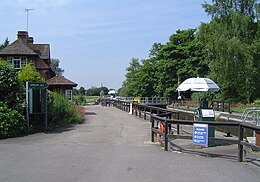
Summary
| Abingdon Lock | |
|---|---|
 Abingdon Lock with Abingdon downstream in the distance. The silver parasols are to shade the lock-keeper while operating the controls. Yellow boards on the gates indicate a high stream | |
 | |
| 51°40′14″N 1°16′09″W / 51.670535°N 1.269202°W | |
| Waterway | River Thames |
| County | Oxfordshire |
| Maintained by | Environment Agency |
| Operation | Hydraulic |
| First built | 1790 |
| Latest built | 1905 |
| Length | 36.57 m (120 ft 0 in) [1] |
| Width | 5.71 m (18 ft 9 in)[1] |
| Fall | 1.89 m (6 ft 2 in)[1] |
| Above sea level | 167' |
| Distance to Teddington Lock | 85 miles |
Abingdon Lock | ||||||||||||||||||||||||||||||||||||||||||||||||||||||||||||||||||||||||||||||||||||||||||||||||||
|---|---|---|---|---|---|---|---|---|---|---|---|---|---|---|---|---|---|---|---|---|---|---|---|---|---|---|---|---|---|---|---|---|---|---|---|---|---|---|---|---|---|---|---|---|---|---|---|---|---|---|---|---|---|---|---|---|---|---|---|---|---|---|---|---|---|---|---|---|---|---|---|---|---|---|---|---|---|---|---|---|---|---|---|---|---|---|---|---|---|---|---|---|---|---|---|---|---|---|
| ||||||||||||||||||||||||||||||||||||||||||||||||||||||||||||||||||||||||||||||||||||||||||||||||||



